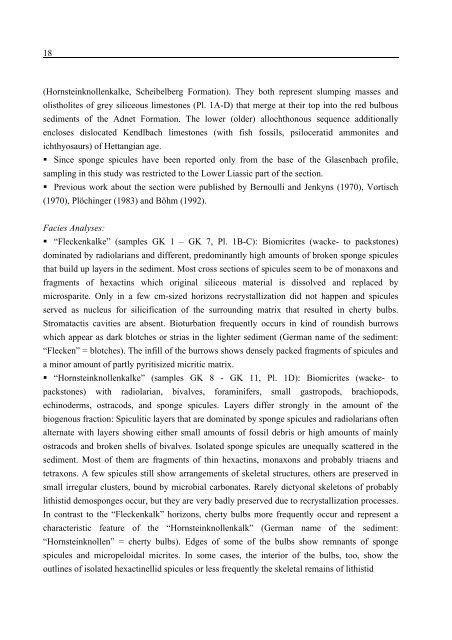Porifera-microbialites of the Lower Liassic (Northern Calcareous ...
Porifera-microbialites of the Lower Liassic (Northern Calcareous ...
Porifera-microbialites of the Lower Liassic (Northern Calcareous ...
Create successful ePaper yourself
Turn your PDF publications into a flip-book with our unique Google optimized e-Paper software.
18<br />
(Hornsteinknollenkalke, Scheibelberg Formation). They both represent slumping masses and<br />
olistholites <strong>of</strong> grey siliceous limestones (Pl. 1A-D) that merge at <strong>the</strong>ir top into <strong>the</strong> red bulbous<br />
sediments <strong>of</strong> <strong>the</strong> Adnet Formation. The lower (older) allochthonous sequence additionally<br />
encloses dislocated Kendlbach limestones (with fish fossils, psiloceratid ammonites and<br />
ichthyosaurs) <strong>of</strong> Hettangian age.<br />
� Since sponge spicules have been reported only from <strong>the</strong> base <strong>of</strong> <strong>the</strong> Glasenbach pr<strong>of</strong>ile,<br />
sampling in this study was restricted to <strong>the</strong> <strong>Lower</strong> <strong>Liassic</strong> part <strong>of</strong> <strong>the</strong> section.<br />
� Previous work about <strong>the</strong> section were published by Bernoulli and Jenkyns (1970), Vortisch<br />
(1970), Plöchinger (1983) and Böhm (1992).<br />
Facies Analyses:<br />
� “Fleckenkalke” (samples GK 1 – GK 7, Pl. 1B-C): Biomicrites (wacke- to packstones)<br />
dominated by radiolarians and different, predominantly high amounts <strong>of</strong> broken sponge spicules<br />
that build up layers in <strong>the</strong> sediment. Most cross sections <strong>of</strong> spicules seem to be <strong>of</strong> monaxons and<br />
fragments <strong>of</strong> hexactins which original siliceous material is dissolved and replaced by<br />
microsparite. Only in a few cm-sized horizons recrystallization did not happen and spicules<br />
served as nucleus for silicification <strong>of</strong> <strong>the</strong> surrounding matrix that resulted in cherty bulbs.<br />
Stromatactis cavities are absent. Bioturbation frequently occurs in kind <strong>of</strong> roundish burrows<br />
which appear as dark blotches or strias in <strong>the</strong> lighter sediment (German name <strong>of</strong> <strong>the</strong> sediment:<br />
“Flecken” = blotches). The infill <strong>of</strong> <strong>the</strong> burrows shows densely packed fragments <strong>of</strong> spicules and<br />
a minor amount <strong>of</strong> partly pyritisized micritic matrix.<br />
� “Hornsteinknollenkalke” (samples GK 8 - GK 11, Pl. 1D): Biomicrites (wacke- to<br />
packstones) with radiolarian, bivalves, foraminifers, small gastropods, brachiopods,<br />
echinoderms, ostracods, and sponge spicules. Layers differ strongly in <strong>the</strong> amount <strong>of</strong> <strong>the</strong><br />
biogenous fraction: Spiculitic layers that are dominated by sponge spicules and radiolarians <strong>of</strong>ten<br />
alternate with layers showing ei<strong>the</strong>r small amounts <strong>of</strong> fossil debris or high amounts <strong>of</strong> mainly<br />
ostracods and broken shells <strong>of</strong> bivalves. Isolated sponge spicules are unequally scattered in <strong>the</strong><br />
sediment. Most <strong>of</strong> <strong>the</strong>m are fragments <strong>of</strong> thin hexactins, monaxons and probably triaens and<br />
tetraxons. A few spicules still show arrangements <strong>of</strong> skeletal structures, o<strong>the</strong>rs are preserved in<br />
small irregular clusters, bound by microbial carbonates. Rarely dictyonal skeletons <strong>of</strong> probably<br />
lithistid demosponges occur, but <strong>the</strong>y are very badly preserved due to recrystallization processes.<br />
In contrast to <strong>the</strong> “Fleckenkalk” horizons, cherty bulbs more frequently occur and represent a<br />
characteristic feature <strong>of</strong> <strong>the</strong> “Hornsteinknollenkalk” (German name <strong>of</strong> <strong>the</strong> sediment:<br />
“Hornsteinknollen” = cherty bulbs). Edges <strong>of</strong> some <strong>of</strong> <strong>the</strong> bulbs show remnants <strong>of</strong> sponge<br />
spicules and micropeloidal micrites. In some cases, <strong>the</strong> interior <strong>of</strong> <strong>the</strong> bulbs, too, show <strong>the</strong><br />
outlines <strong>of</strong> isolated hexactinellid spicules or less frequently <strong>the</strong> skeletal remains <strong>of</strong> lithistid

















